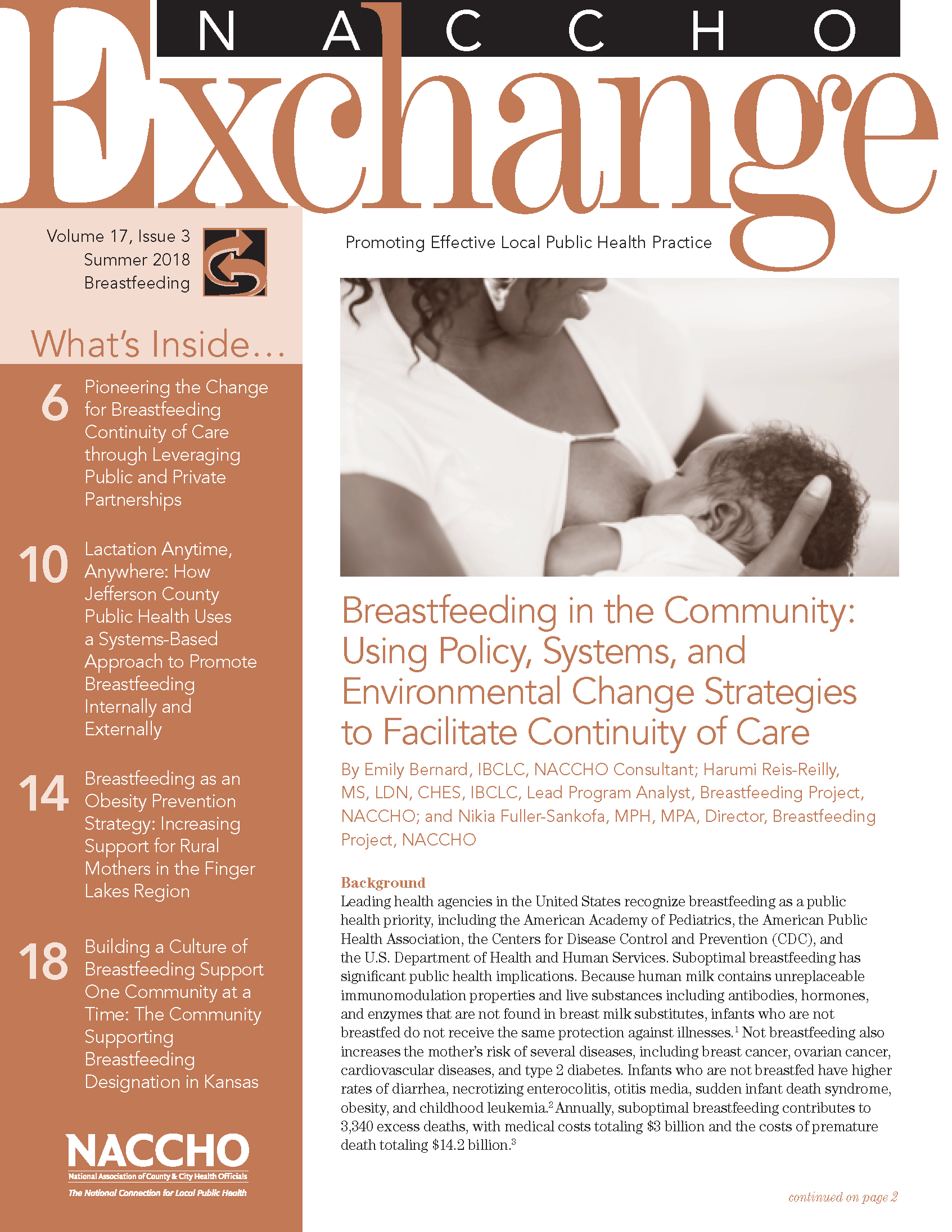 The summer 2018 issue of NACCHO Exchange showcases the ways in which local health departments are implementing policy, systems, and environment changes to increase breastfeeding rates in their communities. Below is an excerpt from the issue.
The summer 2018 issue of NACCHO Exchange showcases the ways in which local health departments are implementing policy, systems, and environment changes to increase breastfeeding rates in their communities. Below is an excerpt from the issue.
By Emily Bernard, IBCLC, NACCHO Consultant; Harumi Reis-Reilly, MS, LDN, CHES, IBCLC, Lead Program Analyst, Breastfeeding Project, NACCHO; and Nikia Fuller-Sankofa, MPH, MPA, Director, Breastfeeding Project, NACCHO
Breastfeeding in the Community: Using Policy, Systems, and Environmental Change Strategies to Facilitate Continuity of Care
Background
Leading health agencies in the United States recognize breastfeeding as a public health priority, including the American Academy of Pediatrics, the American Public Health Association, the Centers for Disease Control and Prevention (CDC), and the U.S. Department of Health and Human Services. Suboptimal breastfeeding has significant public health implications. Because human milk contains unreplaceable immunomodulation properties and live substances including antibodies, hormones, and enzymes that are not found in breast milk substitutes, infants who are not breastfed do not receive the same protection against illnesses.1 Not breastfeeding also increases the mother’s risk of several diseases, including breast cancer, ovarian cancer, cardiovascular diseases, and type 2 diabetes. Infants who are not breastfed have higher rates of diarrhea, necrotizing enterocolitis, otitis media, sudden infant death syndrome, obesity, and childhood leukemia.2 Annually, suboptimal breastfeeding contributes to 3,340 excess deaths, with medical costs totaling $3 billion and the costs of premature death totaling $14.2 billion.3
Through Healthy People 2020, U.S. national objectives have been established to increase the proportion of infants who are breastfed. The good news is that there has been a steady upward trend in the percentage of breastfed infants. In the CDC’s latest National Immunization Survey, aggregated data from infants born in 2014 show that most of the U.S. national breastfeeding goals have been met. Unfortunately, this achievement has not been equitably shared across all subsets of the population. Non-Hispanic black (black) infants born in 2014 have not met any of the U.S. national breastfeeding goals, while non-Hispanic white (white) infants met or exceeded all of them. On average, there is a 17% gap in breastfeeding initiation between black and white infants born between 2009 and 2014, according to the CDC’s data. These inequities put socially disadvantaged women and babies at higher risk for poor postnatal outcomes and chronic conditions, and may well be substantial contributors to the beginning of lifelong health inequities.4 Breastfeeding is beneficial to almost all mothers and infants, but the benefits may be significantly greater for minority women, who are disproportionately affected by adverse health outcomes, which may improve with breastfeeding.5
Through local assessments, LHDs will be able to identify their unique levers for change pertaining to breastfeeding. LHDs may implement family-friendly workplace support policies and work with businesses and childcare providers to reduce barriers for mothers returning to work or school, as the two Colorado LHDs in this issue demonstrate. This issue also highlights the work of two NACCHO Breastfeeding Project grantees: S2aY, a rural network of LHDs that leveraged skills, funds, and incorporated breastfeeding into its community health improvement plan under the obesity prevention goals; and Contra Costa Health Services, which closed the breastfeeding continuity of care gap that existed for low income African American families within its community. This issue also offers other inspiring stories about the unique work of LHDs across the country to address and advance breastfeeding in their communities.
To read the rest of this article and the full issue of NACCHO Exchange, click here.


